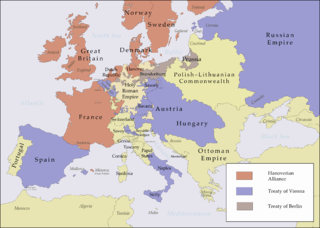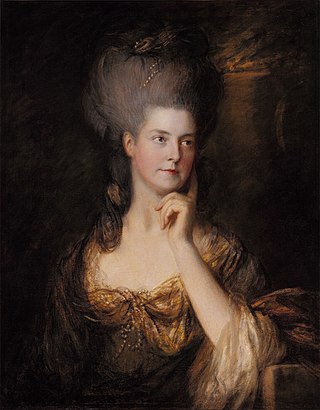Other years |
Sport |
Events from the year 1725 in Great Britain .
Other years |
Sport |
Events from the year 1725 in Great Britain .
The 1720s decade ran from January 1, 1720, to December 31, 1729. In Europe it was a decade of comparative peace following a lengthy period of near continuous warfare with treaties ending the War of the Quadruple Alliance and the Great Northern War. Both Britain and France saw major financial crashes at the beginning of the decade with the South Sea Bubble and the Mississippi Company respectively. Nonetheless it was a decade of stability in both countries under the leadership of Robert Walpole and Cardinal Fleury and the two nations, recently enemies, formed the Anglo-French Alliance.

1726 (MDCCXXVI) was a common year starting on Tuesday of the Gregorian calendar and a common year starting on Saturday of the Julian calendar, the 1726th year of the Common Era (CE) and Anno Domini (AD) designations, the 726th year of the 2nd millennium, the 26th year of the 18th century, and the 7th year of the 1720s decade. As of the start of 1726, the Gregorian calendar was 11 days ahead of the Julian calendar, which remained in localized use until 1923.

1725 (MDCCXXV) was a common year starting on Monday of the Gregorian calendar and a common year starting on Friday of the Julian calendar, the 1725th year of the Common Era (CE) and Anno Domini (AD) designations, the 725th year of the 2nd millennium, the 25th year of the 18th century, and the 6th year of the 1720s decade. As of the start of 1725, the Gregorian calendar was 11 days ahead of the Julian calendar, which remained in localized use until 1923.

Robert Walpole, 1st Earl of Orford,, known between 1725 and 1742 as Sir Robert Walpole, was a British statesman and Whig politician who, as First Lord of the Treasury, Chancellor of the Exchequer, and Leader of the House of Commons, is generally regarded as the de facto first Prime Minister of Great Britain.

Jonathan Wild, also spelled Wilde, was a London underworld figure notable for operating on both sides of the law, posing as a public-spirited vigilante entitled the "Thief-Taker General". He simultaneously ran a significant criminal empire, and used his crimefighting role to remove rivals and launder the proceeds of his own crimes.

Sawrey Gilpin was an English animal painter, illustrator, and etcher who specialised in paintings of horses and dogs. He was made a Royal Academician.

Maria, Duchess of Gloucester and Edinburgh was a member of the British royal family. She was the Countess Waldegrave from 1759 to 1766, as a result of her first marriage to James Waldegrave, 2nd Earl Waldegrave. Her second husband was Prince William Henry, Duke of Gloucester and Edinburgh, whom she married in 1766.

Frederick Keppel was a Church of England clergyman, Bishop of Exeter.
Events from the year 1821 in the United Kingdom. This is a census year.
Events from the year 1724 in Great Britain.
Events from the year 1757 in Great Britain.
Events from the year 1797 in Great Britain.

Catherine, Lady Walpole was the first wife of the first British prime minister Sir Robert Walpole.
Events from the year 1726 in Great Britain.
Events from the year 1740 in Great Britain.
The Faulknor family was an English family from Northamptonshire, of which several generations served as officers in the Royal Navy.

Sir Edward Walpole KB PC (Ire) was a British politician, and a younger son of Sir Robert Walpole, Prime Minister from 1721 to 1742.

Philippe Mercier was an artist of French Huguenot descent from the German realm of Brandenburg-Prussia, usually defined to French school. Active in England for most of his working life, Mercier is considered one of the first practitioners of the Rococo style, and is credited with influencing a new generation of 18th-century English artists.
Events from the year 1876 in the United States.
The Life and Death of the Late Jonathan Wild, the Great is a satiric novel by Henry Fielding. It was published in 1743 in Fielding's Miscellanies, third volume. It is a satiric account of the life of London underworld boss Jonathan Wild (1682–1725). It is an experiment in the various narrative genres that were popular at the time: serious history, criminal biography, political satire, and picaresque novel. Some have argued that it is mainly a satire on Britain's first Prime Minister Robert Walpole, who was continuously charged by his political enemies with allegations of corruption.
At Catherine's urging, "Billings went into the room with a hatchet, with which he struck Hayes so violently that he fractured his skull" but did not kill him. Wood, "taking the hatchet out of Billings's hand, gave the poor man two more blows, which effectually dispatched him." They were then faced with the problem of how to dispose of the body.